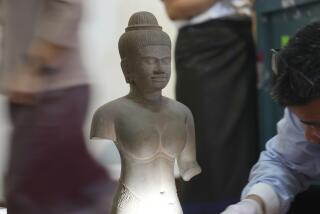Renaissance for Remnants of Lost Kingdom
- Share via
DA NANG, Vietnam — Plans to expand the local Cham Museum didn’t cause much of a stir here in Da Nang. But historians took note: Rather than enjoying a renaissance, they said, the cultural treasures easily could have disappeared, succumbing to years of war, greed and neglect.
The museum, built by colonial France in 1915, houses 300 sandstone and terra-cotta objects from the Champa empire, which flourished in central Vietnam for more than 1,000 years before it was defeated in the 15th century by northern Vietnamese. The battle cost the Chams 36,000 prisoners, including their king and 50 members of his royal family, and 60,000 dead.
Though not as imposing as the temples of Angkor in neighboring Cambodia, Cham architecture and art represent the finest produced in Vietnam, according to many art historians.
The kingdom slowly disintegrated after the decisive battle, and Vietnam’s Cham population today numbers only 80,000. Still, Western sociologists consider it unusual for Vietnam, an ultranationalistic nation, to honor the culture of an enemy that it had fought for centuries.
“Historically, Vietnam has had enemies in the past that are friends today, so this is a natural progression,” said Phan Van Canh, vice director of Da Nang’s museums. “Also, Ho Chi Minh [modern Vietnam’s founding father] always said all people in Vietnam represented one nation and deserved equal respect.”
Canh, who has a master’s degree in cultural studies from Vietnam National University in Hanoi, moved among the 600- to 1,400-year-old statues recently as though he were discovering old friends. “This,” he said, stopping by one--a dragon--”is one of my favorites. Beautiful, graceful lines. It was carved when the Champa empire was at its peak.”
The decision by officials in Da Nang to add several rooms and display some statues now in storage may have as much to do with economics as culture. The open-air museum on the banks of the Han River draws 70,000 visitors a year--the majority of them foreigners--and has become a top attraction in central Vietnam, which is eager to cash in on the country’s growing tourist industry.
To many historians, it is a wonder that art from the Indian-influenced Champa empire survived at all. When the colonialist French were forced out of Vietnam after their 1954 defeat at Dien Bien Phu, many valuable pieces went with them and are now displayed in European museums.
During the Vietnam War--or the American War, as it is called here--South Vietnamese army rangers used the museum as a billet and its courtyard as a toilet. President Johnson persuaded the Saigon regime to remove its troops after seeing a newspaper article questioning the wisdom of desecrating a cultural site.
In 1969, U.S. B-52 bombers targeted My Son, the main Cham holy site, where ancient temples, altars and statues remain to this day. The bombing of My Son was called off after President Nixon received a letter of protest from the curator of the Guimet Museum of Asian Art in Paris.
In the aftermath of the Vietnam War, four pieces were stolen from the Cham Museum, which then had no fence or shuttered windows. The postwar Communist government showed little interest in cultural preservation; the museum was abandoned and didn’t see any tourists for years.
The museum gained a second life in the 1980s when Tran Ky Phuong, Vietnam’s foremost Cham expert, became curator. He persuaded the city government to put a security fence around the property and spend $100,000 for repairs.
Ky also promoted the museum as a cultural heritage and worked with Asian art specialists from the U.S., Japan and France. An exhibition of photographs and models of the museum’s sculptures toured Japan in 1994.
Unfortunately, the museum’s money got mixed up with Ky’s personal funds, a Da Nang official explained. Ky was sentenced to seven years in prison for corruption in 1997. He was recently released in an amnesty granted thousands of prisoners throughout the country.
Canh said he thinks that the museum’s troubled times are now in the past. The number of tourists is growing, he added, and “some day maybe we’ll even be able to have an exhibition of original Cham sculptures in New York or London.”
More to Read
Sign up for The Wild
We’ll help you find the best places to hike, bike and run, as well as the perfect silent spots for meditation and yoga.
You may occasionally receive promotional content from the Los Angeles Times.






